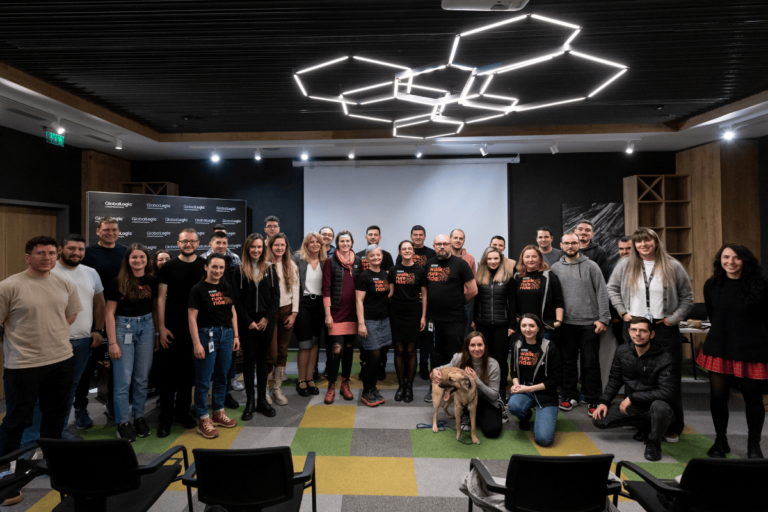- Services
Technology Capabilities
Technology Capabilities- Product Strategy & Experience DesignDefine software-driven value chains, create purposeful interactions, and develop new segments and offerings
- Digital Business TransformationAdvance your digital transformation journey.
- Intelligence EngineeringCreate high-value products faster with AI-powered and human-driven
- Software Product EngineeringCreate high-value products faster with AI-powered and human-driven engineering.
- Technology ModernizationTackle technology modernization with approaches that reduce risk and maximize impact.
- Embedded Engineering & IT/OT TransformationDevelop embedded software and hardware. Build IoT and IT/OT solutions.
- Industries
- GlobalLogic VelocityAI
- Insights
White PapersSeptember 17, 2024Diana SocaciuElevating Romanian Tourism with GlobalLogic: Apuseni App
The innovative banking apps, such as the one we'll explore in this case study, succeed ...
 Case StudiesGlobalLogic
Case StudiesGlobalLogicFrom Legacy to Leading-edge: A Global Software Leader’s ...
Discover how GlobalLogic’s AI-powered solutions helped a global software leader migrate...

- About
Published on January 10, 2024Connected Car Software Development: How to Get it Right
View all articlesVencel Biro.NET Competency Head | EngineeringShareRecommended authorsSenior Vice President & General Manager, Healthcare & LifesciencesPrincipal, Financial Services Lead at MethodView all authorsGroup Vice President and Head of UK&I and Emerging Markets
Industry Leader, Financial Services and Consumer, EMEALet's start engineering impact together
GlobalLogic provides unique experience and expertise at the intersection of data, design, and engineering.
Get in touchMobilityCars have been part of our lives for quite some time, but in recent years digital disruption has catapulted the industry to new heights with the introduction of the connected car. As digital transformation has engulfed the automotive industry, OEMs have been able to leverage a few things.Everything from advancements in digital communication to the influx of IoT-connected devices and enhanced wireless connectivity has been used to create software-driven vehicles that meet and promise to surpass customer expectations.
According to Statista, “the global connected car market is estimated to reach about 65 billion US dollars in 2021, up from some 56 billion US dollars in 2020. It is expected that the market will recover from the impact of the global coronavirus pandemic and grow to around 121 billion US dollars by 2025.″ . While there is still plenty of room for growth with the connected car, the journey isn’t without challenges. Consequently, as companies in the automotive industry aim to be at the forefront of the future of mobility, they must also be wary of the potential pitfalls that can affect them.
This article outlines some of the challenges and pitfalls that manufacturers need to be aware of and highlights how they can overcome these challenges with adequate automotive software development support.
Table of Contents
- What Is a Connected Car? (And Why Is It So Valuable?)
- Challenges & Pitfalls of Connected Car Software Development
- To Overcome Software Complexity and Delays in Production OMEs Turn to Specialized Software Development Companies
What Is a Connected Car? (And Why Is It So Valuable?)
McKinsey’s 2020 consumer survey on autonomous driving, connectivity, electrification, and shared mobility (ACES) shows that “37 percent of respondents would switch car brands to achieve improvements in this area. In some countries, the percentage of consumers willing to switch brands for improved connectivity was even higher (56 percent in China, for instance). Similarly, 39 percent of consumers were interested in unlocking additional digital features after purchasing a vehicle—a figure that rises to 47 percent for customers of premium OEMs. Given connectivity’s increasing importance, OEMs that fail to meet the bar risk losing customers”.
To properly grasp the challenges of developing software for the connected car, it’s necessary to understand the essential components of a connected car and how it has changed modern vehicle architecture.
Traditionally, vehicle architecture included three siloed systems: infotainment, diagnostics, and telematics.
- Infotainment includes the audio and video interfaces, keypads, and touchscreens used to provide passengers with entertainment and information.
- Diagnostics measures performance details related to the engine, transmission, brakes, exhaust, and other components that facilitate the vehicle’s actual operation.
- Telematics systems handle all vehicle tracking and telemetry data, including speed, location, fuel consumption, idle time, and more.
Before connected cars, these systems remained siloed with little to no communication between them. However, after the invention of more advanced connectivity like LTE, these siloes were broken. The result has been an upgrade of modern car architecture to feature real-time tracking and diagnostics and a marked increase in the overall user experience.
Connected car software development aids OEMs to bridge the gap between mobile and cars by facilitating the collection, use, and processing of data from various car devices, sensors, and subsystems.
Real-time analytics are generated in the cloud from data gathered on the ground, and passengers can now connect their smartphones to further interact with their vehicles. In an increasingly consumer-driven world, connected cars have provided a taste of what the future of transportation may look like, no matter who is driving.
However, while connected vehicles offer significant customer experience improvements, the potential for increased safety, and environmental benefits, developing software for these cars is not without challenges.
Challenges & Pitfalls of Connected Car Software Development
Here are some of the software development challenges OEMs need to be wary of:
Development Time & Costs
For OEMs, connected cars represent a new era. Adopting a whole new way of doing business, one in which connectivity is in the driver’s seat, will pose significant challenges. A sector in which products are developed in multi-year cycles will be forced to shift to shorter life cycles for a model. To include the latest software developments, automakers will accelerate the development of connected cars to as low as one-year cycles.
With the swift changes in OS systems and applications, it can be hard to provide upgrades and keep connected car software up to date. Consequently, the costs of facilitating connected car technology could eventually become expensive for OEM manufacturers and the consumers who use the cars.
Similar to a smartphone, there must be a bill to keep these devices connected to networks. As more cars are rolled out, developers will need to find ways to lower costs and development time without impacting manufacturers or the end-user.
Adjusting to Trends and Complexity
A connected car enhances the user experience, but consumers’ habits continue to change rapidly. Compared with the time it takes to roll out new car technology effectively, new entrants into the market may find themselves behind the curve before they even begin.
As trends such as shared vehicles, ride-sharing platforms, and more continue to accelerate, OEM manufacturers will need to weigh their ability to satisfy consumer requirements with the pace of development.
As a result, software development will need to be sped up, and OEMs will need to partner with experienced developers to handle the demand and avoid the risk of making costly mistakes.
Network and Security
Connected cars offer new and easier ways to enter vehicles and connect personal devices. However, these methods also expose cars to the possibility of being hacked. Hackers can exploit weaknesses in anything from ECUs to CAN.
Some of the most common ways include key fob and mobile app attacks. Therefore, cards need to utilize threat detection technology and security logins similar to any other computerized system.
Establishing OEM & Connectivity Partnerships
To facilitate enhanced coverage for connected cars, OEMs need to partner with telecommunication companies to ensure compatibility with networks such as 5G. Reliable and uninterrupted coverage will need to be available across several markets to facilitate the connected car’s vast growth.
This means that software teams will need to build scalable, cost-effective, and easily upgradable software solutions that can be installed across various types of hardware and vehicles on a global scale.
To Overcome Software Complexity and Delays in Production, OMEs Turn to Specialized Software Development Companies
Vehicle developers face a radical transformation of the automotive world, one in which software is as essential as mechanical ingenuity. McKinsey expects that the market for car electronics and software will grow much faster than the overall automotive market in the next decade, and with 39% of buyers already choosing their next vehicle based on digital features, OEMs, tier-one suppliers, and software companies are shifting to a new collaboration model.
Automotive software development is creating challenges for all automakers, as a typical new-generation vehicle likely has a software architecture composed of hundreds of functional components in the car and the cloud. To build such a complex architecture, OEMs must turn to software development teams to create, integrate, and upgrade the software innovations users expect, from infotainment and ADAS to mapping, telematics, and third-party applications. As Thomas M. Müller said, “automotive OEMs strengthen working models and commercial models with specialized software suppliers and software developers to maintain the role of key orchestrators in the value chain.”
As on-board processing power and data flow capacity needs to increase from model to model, and software complexity will nearly triple in a decade, specialized software companies are joining the automotive industry supply chain to help steer the transformation of the vehicle by developing custom software for the connected car.
To address the widening gap between software complexity and productivity levels, OEMs must choose a partner that can provide a dedicated connected car software development team. Connectivity inside a vehicle is vital, and our software engineers are tech-focused and ready to take a software-based approach to car development.
 How can I help you?
How can I help you?
Hi there — how can I assist you today?
Explore our services, industries, career opportunities, and more.
Powered by Gemini. GenAI responses may be inaccurate—please verify. By using this chat, you agree to GlobalLogic's Terms of Service and Privacy Policy.


